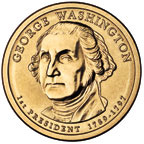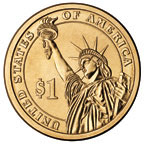
The Story
When you hear the word "dollar," you probably think of the basic unit of money in the United States, whether paper or golden coins. But our first dollars were coins made of silver. The word "dollar" comes from the German word "thaler," which was a large silver German coin.
Because lots of people around the world used these silver "thalers," other countries began making their own versions. American colonists were used to using the Spanish dollar, a coin often used in the nearby lands that traded with the colonies. So "dollar" was a pretty easy choice as a name for the brand-new currency of the United States.
The dollar was one of the first silver coins made in the United States, back in 1794. Over the years, there were times when dollar coins were not made, and people used other denominations. But the dollar coin is back in production again, only it is no longer made of silver.
The coin's golden color does not come from gold, but a special mixture of copper, zinc, manganese, and nickel. This mix not only looks golden to human eyes, but "looks" like the silver-colored Susan B. Anthony dollar to vending machines. Despite their different color, both silvery and golden dollars have the same "electromagnetic signature," so they can both be "read" by the same machines.
A Presidential Gallery, Since 2007
The Presidential $1 Coin Program began with our first President, George Washington, and continues with each President in order of service, four new designs every year. As these coins are released, it's a great time to take a look at these leaders, their struggles and successes, and how they helped make America great.
Other cool features of these coins are the Statue of Liberty on the back and the incused wording on the edge. Read more about this series through the links below.



All That Glitters, Since 2000
The Golden Dollar shows Sacagawea, the young Shoshone Indian woman who traveled with and helped Lewis and Clark to explore the territory called "Louisiana." The baby she carries on her back was the youngest member of the party. He was born during the expedition.
Most of our other circulating coins went from images of Liberty to images of Presidents, but Sacagawea wasn't the first to replace Liberty on the dollar. President Dwight D. Eisenhower was first, then suffragist Susan B. Anthony. You can learn more about those dollar designs through the links below.
Native American $1 Coins in 2009
Beginning in 2009, the United States Mint will issue coins that celebrate American Indians and their historic contributions to the development of the United States. The design on the back will change each year to depict such a contribution. As much as possible, the coin designs will be issued in the same order as the events or persons featured in the designs.
The back will also be inscribed with "$1" and "United States of America." The "Sacagawea" design will appear on the front of each coin along with the inscription "Liberty." Like the Presidential $1 Coins, the Native American $1 Coins will keep the golden color and edge-lettered year, mint mark, "E Pluribus Unum," and "In God We Trust."
So five coins will be issued each year (four Presidential $1 Coins and one Native American $1 Coin), with the Native American coins making up at least 20 percent of the total. After the Presidential $1 Coin Program ends in 2016, the Native American $1 Coin Program will continue.
Learn all about this program and see the designs on the Native American $1 Coins page!
Dollar Lexicon
- Another day, another dollar (another day of work has ended)
- I bet dollars to donuts (I'm sure enough to bet at good odds)
- Bet your bottom dollar (bet your last coin)
- Make a buck (earn money)
- More bang for the buck (more value or power for the same amount of money)
- Dollar days (days when a store offers major sales)



Other Dollar Resources
- There's a whole section on the Presidential $1 Coin Program right next door, here in Coin News!
- The George Washington $1 coin was Coin of the Month in February 2007.
- Read more about the making of the Golden Dollar featuring Sacagawea in the summer 2001 issue of Making Cents.
- The Susan B. Anthony dollar was featured as the August 2000 Coin of the Month.
- The Eisenhower dollar was featured as the July 2000 Coin of the Month.
- Many commemorative coins are silver dollars. Recent commemorative dollars are listed under "Commemorative Coins."
- You can hold a Ferris wheel in the palm of your hand: Fun Fact
- $10 billion goes a long way: Fun Fact
- Two different dollars were both first: Fun Fact
- So you think you know how much a Continental dollar is worth? Fun Fact
- Ben Franklin made lots of money...but whose? Fun Fact
Teachers! Looking for lessons based on the coins in our pockets? Check out Coin Curricula and the Presidential $1 Coin Lesson Plans..
See the
previous coin
Return to
"Circulating Coins" page
